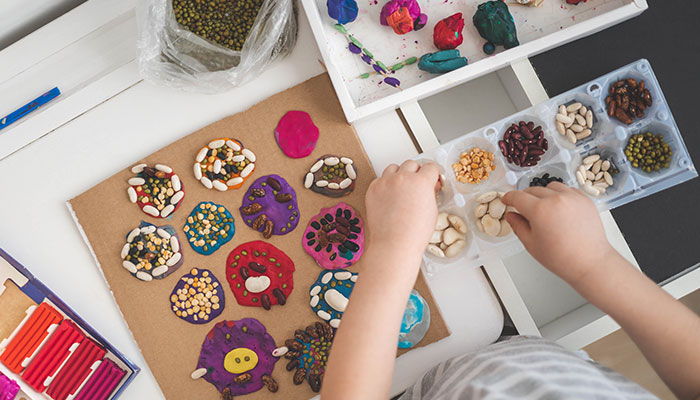While we believe that the books and resources recommended may be of value to you, keep in mind that these are suggestions only and you must do your own due diligence to determine whether the materials are appropriate and suitable for your use. PNC has no sponsorship or endorsement agreement with the authors or publishers of the materials listed.
SPRING

Seed Mosaics
The children will investigate seeds.

Lesson Objective
The children will discover the characteristics of seeds and use the seeds to create a picture.
ScienceArt
What You'll Need
- magnifying glasses – 1 per child
- paper towels
- small paper plates – 4 per child
- large paper plates – 1 per child
- glue – 1 bottle per child
- a variety of seeds – enough for each child to make a collage of seeds on their poster board
- poster board cut into a maximum of 8” x 10” sheets
What To Do
Note: Pre-cut the poster board so each child has a maximum of an 8” x 10” sized sheet with which to work. Be sure to provide a wide variety of seeds with different colors, patterns, and textures. Small fingers handle large seeds more easily than small seeds.
- Provide each child with one of each type of seed on their paper towel and a magnifying glass. Place the remaining seeds in a pile on a large paper plate.
- Explain to the children that they are going to examine what is on the paper towel, and then use them to make a picture.
- Give children a few minutes to examine the seeds, and then ask them to describe what is on their paper towels (see Guiding Student Inquiry and Did You Know?).
- Distribute a large plate of seeds for each child and the small paper plates to use to sort their seeds.
- Have the children sort their seeds; allow them to lead the sorting, such as large seeds, small seeds, seeds with more than one color, and seeds that are all one color.
- As they are sorting their seeds, ask children how they are sorting their seeds – by color, shape, size, pattern, or texture (see Guiding Student Inquiry).
- Guide the discussion about the seeds by having children share with classmates how they sorted their seeds.
- Distribute poster board and glue to the children.
- Tell the children that they will now have a turn to create a picture using their seeds and glue.
- Allow children to create a picture by gluing the seeds on the poster board.
Resources
Home School Resources
Home educators: use these printable lesson PDFs to teach this lesson to your home schoolers. They're available in English and Spanish.
Content Provided By
Common Core State Standards Initiative – These lessons are aligned with the Common Core State Standards ("CCSS"). The CCSS provide a consistent, clear understanding of the concepts and skills children are expected to learn and guide teachers to provide their students with opportunities to gain these important skills and foundational knowledge [1]. Visit the CCSS


